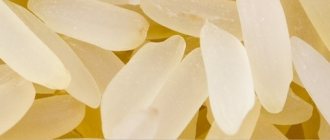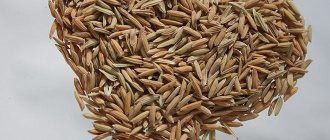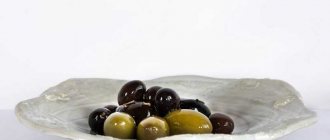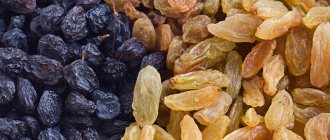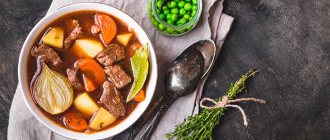Rice is one of the oldest grain crops on the planet. Scientists believe the plant is at least 5,000 years old and is a staple food for more than half the world's population. The main consumers of rice are residents of South and East Asia. White grains are most commonly consumed, but brown (unpolished) rice has become increasingly popular in the Western world in recent years as a healthy food.
general characteristics
Content:
- general characteristics
- White vs brown
- Useful components
- Beneficial features
- Cautions
- How to choose the right rice
- What is it suitable for?
- Rice water in cosmetology
Rice is an annual cereal plant popular in Asian countries. It is believed to be the second most common cereal on the planet (after corn). It is grown on all continents except Antarctica. There are more than 40 thousand varieties of this cereal, but the white or unpolished product is most often used as food. Depending on the method of grain processing, its taste varies. Therefore, different varieties of rice are used for different dishes.
In addition, in cooking it is customary to distinguish rice by the length of the grain. Thus, in Indian and Chinese cuisine, long-grained grains are more often used; in Western countries, short or round grains are preferred.
In addition to the traditional white grain, other types of rice are also used for food: brown, red, purple and even black.
How does rice work for weight loss?
When losing weight, simple and affordable rice will be especially useful. However, we note that it is often not used when losing excess weight. This is very in vain, because this product helps to cleanse the body and, most importantly, it contains all the important useful components.
Ordinary and affordable rice can provide invaluable benefits in the fight for a slim figure, although it is usually not customary to use the product when losing weight, but in vain. Cereal perfectly cleanses the body and contains necessary and beneficial components.
Proper use of such a product in the fight for an ideal figure includes:
- limited time period (using such a diet for a long time is very undesirable, because rice is known for its ability to cause a calcium deficiency in the body);
- compliance with restrictions (pregnant and lactating women, children, people suffering from gastritis and peptic ulcers).
Note that to obtain a good result, it is not the type of rice that matters, but the rate at which it is consumed.
To properly prepare dietary rice, we recommend rinsing it with cold water in the evening and leaving it overnight. In the morning, drain the water and prepare it using your usual method. Note that rice cooked in water is the best helper for those who are losing weight.
Effect of the rice diet
Of course, for those who want to lose excess weight, before going on a rice diet, you need to find out about the results of such a diet:
- Rice is a very healthy product for those who are losing weight. The most important benefit of rice is that it helps cleanse the body of toxins. Along with cleansing, your state of health also improves.
- To start a long and serious diet, we recommend starting with a small deload. The rice diet will help you here.
- If you are trying to lose weight on rice, then such weight loss has a long-lasting effect. To consolidate the results obtained, we recommend not consuming “heavy” foods for the next 10 days, this applies to fatty and salty foods.
- The rice diet always gives quick and visible results. In just 7 days of the rice diet you can get rid of 6 kg.
Read: Recommendations for making mozzarella cheese, composition and calorie content of the product
White vs brown
White rice is a refined product, free of bran and germ. These procedures can improve the quality of food, extend the shelf life of grain, and improve its taste. But, as a rule, all this is achieved by reducing the nutritional value of the product.
Brown rice is an intact whole grain rich in fiber, minerals, vitamins and antioxidants. In addition, unrefined grains tend to have a lower glycemic index, which means they are more beneficial for diabetics. But rice bran, among other things, is a source of so-called antinutrients. One of them is phytic acid. In addition, heavy metals can be concentrated in the outer shell of rice (if the grains were grown in contaminated areas).
How to eat rice?
The polished white variety is the least healthy, as it contains the minimum amount of essential vitamins. All of them are mainly located in the shell. Therefore, preference when choosing should be given to the brown, unrefined type and those that retain the shell. Such varieties have more pronounced taste qualities, but, accordingly, their cost is several times higher.
When choosing, you also need to pay attention to friability - there should be no lumps, and also, naturally, insects. The smell is also of great importance - it is absent in a quality product. The size of the grains and their color should not differ too much. It is extremely undesirable to choose crushed rice, since it contains even fewer useful substances than polished rice, and, in addition, various debris is quite often found in such grains.
It is important to know how to store the product correctly. It is best to keep it in a dark cloth bag, and choose a place for this that is dry and cool, where there will be good ventilation. A refrigerator, and many people choose it, is not suitable for these purposes. As a last resort, it is better to use a resealable container or jar, but then it must be used within a month.
The grains are not consumed raw. For the most part, it is eaten boiled with the addition of spices. At the same time, it is worth knowing that overcooked viscous cereals are much easier to digest and absorb, therefore they are especially useful if you have digestive problems. Cooked in moderation and crumbly, it promotes weight loss by increasing the load on the digestive system and speeding up metabolism.
Useful components
Carbohydrates
Rice mainly consists of carbohydrates (approximately 90% of the total mass), which are mainly represented by starches. Starch is the most common form of carbohydrates and is composed of amylose and amylopectin. Both of these substances have different properties that determine the structure and digestibility of the product. Rice rich in amylose (such as basmati) does not stick together after cooking. In addition, amylose slows down the digestion of starch, that is, it contributes to the creation of so-called resistant starch.
In contrast, rice that is low in amylose and amylopectin turns into a sticky substance when cooked. These types of product are suitable for rice puddings, risotto, and for preparing Asian dishes. However, such rice is digested faster and causes sharp spikes in blood sugar levels, which is extremely undesirable for people with diabetes.
Cellulose
Traditional white rice is a low-fiber product (no more than 0.3%), which cannot be said about brown rice, which consists of almost 2 percent dietary fiber. However, both types of rice may contain resistant starch. In its functions, this substance largely resembles fiber and also serves as “food” for beneficial intestinal microflora. In the colon, resistant starch promotes the creation of short-chain fatty acids (butyrates), which improve gut health and prevent cancer.
Vitamins and minerals
The nutritional value of rice is usually determined by the type of product and the cooking method. Many vitamins and minerals are concentrated in the bran and germ, which are exclusively components of brown rice.
So, rice contains:
- manganese is an antioxidant, found in almost any whole grain, important for metabolism, growth and development of the body;
- selenium is a mineral that is the main part of selenoproteins, which are responsible for a variety of functions in the body;
- thiamine (vitamin B1) – necessary for proper metabolism, supports the functionality of the heart, muscles, and nervous system;
- niacin (vitamin B3) – important for most redox reactions in the body (soaking rice in water before cooking will help increase the absorption of the vitamin);
- Magnesium – found in brown rice, important for preventing many chronic diseases;
- Copper – a deficiency of the mineral causes heart disease.
In addition to the components already mentioned, rice contains many plant compounds that are important for maintaining health. The highest levels of antioxidants were found in pigmented cereal varieties. But white rice is absolutely not suitable as a source of these beneficial substances.
Plant compounds in rice:
- lignins - during metabolism they are converted into enterolactone, which performs a variety of functions in the body;
- ferulic acid – a strong antioxidant found in rice bran, protects against cancer, diabetes, and cardiovascular diseases;
- phytic acid is an antioxidant found in unpolished grains, but excessive consumption can impair the absorption of iron and zinc.
Nutritional value of rice per 100 g of product
| Calorie content | 130 kcal |
| Squirrels | 2.5 g |
| Fats | 0.2 g |
| Carbohydrates | 28.7 g |
| Vitamin B1 | 0.16 mg |
| Vitamin B2 | 0.02 mg |
| Vitamin B3 | 1.5 mg |
| Vitamin B5 | 0.5 mg |
| Vitamin B6 | 0.06 mg |
| Folic acid | 59 mcg |
| Calcium | 1 mg |
| Iron | 1.46 mg |
| Magnesium | 8 mg |
| Phosphorus | 33 mg |
| Potassium | 26 mg |
| Zinc | 0.4 mg |
| Manganese | 0.36 mg |
| Selenium | 7.5 mcg |
Varieties of rice
There are more than 30 species of this cereal in nature. On the shelves of our supermarkets only a small part of their diversity is presented. How many carbohydrates are in 100 grams of rice? It will be interesting to know that the most useful and nutritious is the brown variety. This type of cereal is harder than white. In addition, it takes longer to prepare than plain white.
Brown rice is especially valued by world nutritionists, and those who are on a diet adhere to proper nutrition. A large amount of complex carbohydrates saturates the body for a long time. And the rich chemical composition nourishes the body with all the necessary substances. The basmati rice variety is an elite variety.
The grains of this cereal are ultra thin and long, compared to the usual white rice. The product is very tasty and aromatic. We are accustomed to eating the white, purified (polished) type. This cereal cooks quite quickly, and the final dish turns out very tasty, no worse than with basmati.
Beneficial features
Rice is considered one of the healthiest foods in the world. Representatives of different culinary schools argue in what form and in combination with what products rice tastes best. But no matter what dish you prepare from this cereal, its beneficial properties will not change. Here are some of the main benefits of this product.
Energy source
Since rice is rich in carbohydrates, it acts as a “fuel” in the body, supplying energy to the muscles and also activates the brain.
In addition to carbohydrates, this cereal contains a complex of vitamins and minerals, which are also important for active life and improved metabolism.
Heart Health
Cardiovascular diseases, such as heart attacks and strokes, are the leading causes of death worldwide. Observations have shown that consuming whole grains helps reduce this figure. Researchers followed hundreds of men who ate whole grains for breakfast every day for 5 years. As a result, their chance of developing fatal cardiac diseases decreased by almost 20 percent. A similar study in women yielded even more encouraging results: the risk of cardiovascular disorders decreased by more than 30 percent. Other studies have shown that whole grains have a beneficial effect on vascular health in people with obesity or diabetes.
Stable blood pressure
Rice is low in sodium and is considered a good food for people with high blood pressure. Sodium can cause spasms and constriction of blood vessels, which as a result increases the stress on the heart muscle. Sodium-free foods can be considered foods that prevent atherosclerosis, heart attack, stroke and some other cardiovascular diseases.
Cancer Prevention
Whole grain rice is rich in insoluble fiber, which researchers say may reduce the risk of developing various types of cancer. Scientists also suggest that this substance can slow down the metastasis of cancer cells. In particular, it is known that dietary fiber is an excellent preventative against colorectal cancer and oncological degeneration in intestinal tissues.
However, in addition to fiber, rice contains natural antioxidants such as vitamins C and , phenolic compounds and flavonoids, which protect the body from the harmful effects of free radicals. Thus, they prevent mutations at the cellular level and increase the ability to resist dangerous substances and organisms.
Alzheimer's protection
Brown rice is rich in many beneficial substances that stimulate the activity of neurotransmitters. The result of this effect is the prevention of Alzheimer's disease or alleviation of its manifestations. Due to its special chemical composition, wild rice has been shown to stimulate brain cells, increase their protective abilities, and also suppress the harmful effects of free radicals and toxins, which ultimately protects against the development of dementia.
Benefits for digestion
For centuries, rice husks have been used as a remedy against dysentery and also as a diuretic. The Chinese consider this cereal indispensable for people with digestive problems, stomach diseases and lack of appetite. In addition, Easterners use a decoction of rice husks as a means of losing weight and removing toxins from the body. And varieties rich in fiber prevent chronic constipation.
Source of vitamins
The grains of this cereal are a good source of vitamins and minerals. In particular, this product supplies the body with niacin, thiamine, riboflavin, vitamin D, calcium, and iron. These substances are indispensable for the immune system and proper metabolism.
Skin health
Scientific studies of the properties of rice grains have discovered that flour from this grain effectively treats skin diseases.
Residents of Indochina have been using rice ointments to treat skin inflammation for thousands of years. Phenolic compounds found in rice (especially brown or wild rice) have anti-inflammatory properties. In addition, antioxidants protect against early wrinkles.
Other benefits of rice:
- does not contain gluten and cholesterol;
- quickly restores energy;
- improves intestinal motility;
- slows down the aging process;
- activates metabolism;
- improves digestion;
- reduces blood pressure;
- promotes weight loss;
- strengthens the immune system;
- prevents cancer and heart disease.
Nutrients of rice
Rice has many beneficial properties. We'll talk about this below:
- Rice is one of the main sources of several B vitamins: thiamine B1, riboflavin B2, niacin B3 and B6; vitamin PP, carotene, vitamin E. They help improve the nervous system and have a positive effect on the condition of nails, skin and hair.
- This product contains complex carbohydrates, making this product nutritious and low in calories.
- It has a positive effect on weight loss.
- Also, one of the positive aspects of the product is that it contains 8 amino acids. They are necessary for the human body to create new cells.
- Rice grains consist of 9% protein.
- Also worth noting is the fact that rice, unlike other grains, contains absolutely no gluten. Gluten is a plant protein that causes allergic reactions.
- Contains lecithin. It is a popular brain booster, an oligosaccharide that helps repair the gut, and gamma-aminobutyric acid that helps normalize blood pressure.
- This product contains a large amount of potassium. It helps neutralize the effects of salt on the body, which enters the body with other foods.
- This healthy product also contains small amounts of phosphorus, zinc, iron, calcium and iodine.
- Note that quite a lot of nutritionists recommend arranging fasting days on a rice diet. But the most important thing is to be careful. You also need to know how much to use this product. The fact is that it contains sodium in small quantities. Sodium does not release water from the body.
- Rice, especially brown rice, contains a huge range of active substances. It is thanks to such substances that it can be called the best means for removing toxins and excess fluid from the body.
- Rice contains a huge amount of essential vitamins, minerals and trace elements.
- By the way, half of rice consists of starch. Starch is easily digestible and is considered the best source of energy.
- This product contains few calories and many ballast substances that stimulate the digestive system.
Rice is a great option for those who want to lose weight. To get rid of excess weight, we recommend giving preference to brown, unrefined rice. The thing is that such a product is the best solution for getting rid of toxins in the body.
However, this does not mean that you need to give up white refined rice. It can also be consumed, but it is recommended to do it occasionally and for variety.
Read: How to cook couscous so that it is healthy
To preserve its beneficial properties, we recommend consuming it without salt. After all, salt has a negative effect, it binds water and does not release it from the body. That is why it is very important to avoid adding salt. It is also recommended to drink liquid in large quantities.
It is recommended to drink at least two liters of water daily. We also recommend drinking several mugs of herbal teas. In particular, you should pay attention to nettle tea, tea based on birch and juniper leaves. Such varieties have an effect on the removal of toxins and excess fluid from the body.
The amount of its nutrients depends on how much processing the rice grain has undergone. We recommend buying rice from well-known manufacturers and paying attention to what kind of processing it has undergone. After all, during processing it loses its beneficial properties.
Cautions
Type 2 diabetes is one of the reasons to avoid certain types of white rice as a product with a high glycemic index. Also, a study involving more than 64 thousand Chinese women showed that it is enough to eat 300 g of white grains daily to almost double the risk of developing diabetes. Therefore, diabetics are advised to consume only brown rice.
The second possible danger of this cereal is heavy metals, which can concentrate in the bran. For this reason, brown rice may be more dangerous than milled rice.
How many carbohydrates are in brown rice?
100 grams of uncooked brown rice contains about 53 grams of carbohydrates. This amount equates to 40% of the daily carbohydrate requirement. Parboiled brown rice contains up to 31 grams of this substance. During the cooking process, the amount of carbohydrates decreases. Brown cereal is the healthiest. Especially in comparison with the usual white.
The usefulness is explained by the peculiarities of the processing process. The grains are peeled and that's it. The bran and cobs remain unchanged. Bran is extremely beneficial for the intestines and stomach. They rid the body of waste and toxins, which also promotes weight loss. In addition, brown rice has the following beneficial properties:
- Neutralization of the effects of free radicals;
- Removal of radionuclides;
- Cleansing joints;
- Increased protective functions of the body;
- Normalization of metabolic processes;
- Normalization of the functions of the endocrine system;
- Prevention of diabetes.
The product contains about 325 kcal. This is considered low-calorie, so it is customary to eat it during weight loss.
How to choose the right rice
The general rules for purchasing rice are the same as when choosing other cereals. It should be dry, without mold or rotten smell. It is better to take the product in a sealed package, but it is important to check its integrity.
But the process of choosing rice does not end there. Since there are many different varieties of this product, it is good to know which type is best suited for which dish. Here are some tips on how to choose rice.
- Proper rice looks like frosted glass.
- White, like chalk, is a sign of unripe grains; it boils quickly.
- Yellow grains – the product was kept moist for a long time before packaging. It may contain mycotonsins and carcinogens.
Disadvantages of rice
Despite the many benefits of rice, it also has significant disadvantages. So, rice is undesirable for consumption in the following cases:
- Rice should not be eaten in large quantities if you are obese or constipated.
- It is also undesirable to use it for colic.
- For men, rice in large quantities can affect sexual function.
- You should also avoid eating rice regularly to avoid the risk of developing various pathologies.
- As for imported rice, it is harmful, since it is always purified with synthetic substances.
Recommended video:
In conclusion, we note that today rice is known more as a side dish than as an independent product. This is quite strange, since rice has an abundance of useful components. We hope that our article helped you learn about the benefits of this product for the human body.
Read along with this article:
- Is it possible for a nursing mother to have canned pineapples, benefits and harms...
- Pomegranate is eaten with or without seeds, we tell you how to do it correctly
- Do sunflower and pumpkin seeds make you better?
- The ABC of taste: calorie content of smoked capelin
- Recommendations for replacing olive oil
- Dried plum, its beneficial properties. Dietary recipes with prunes
- Is it true or false that milk helps with heartburn?
- Beneficial properties of hemp and its effect on the gastrointestinal tract
- Chemical composition of peanuts, beneficial properties for adults and children
What is it suitable for?
Round grain Japonica - sushi.
Round or medium-grained Arborio - porridge, risotto.
Round or medium-grained Krasnodar - soups, milk porridges.
Long-grain Basmati (considered the best of all varieties) – side dishes, oriental dishes, pilafs.
Long-grain Jasmine - for cooking under the lid, crumbly side dishes.
Long-grain Indica – side dishes, pilafs, salads.
Wild rice (black) – side dishes, salads.
Unpolished (brown) – side dishes, salads, suitable for cooking in large amounts of water.
Red – side dishes, salads.
Classification by grain shape:
- long-grain – oblong, up to 8 mm, crumbly after cooking, used for soups, side dishes, salads, appetizers;
- medium-grain – round, up to 6 mm, sticky after cooking, but does not form lumps, used for porridges, soups, risotto;
- round grain – round, up to 5 mm, sticks together after cooking, used for porridges, soups, casseroles, puddings, desserts, and as a filling for pies.
Calorie content of rice types
Today, there is such a wide variety of rice varieties on store shelves that it’s dizzying! Among them are basmati, red, steamed white and others.
Calorie content of cereals by type:
| Type of rice | Calorie content, kcal |
| White round grain | 344 |
| Brown | 337 |
| Wild | 357 |
| Red | 362 |
| White long grain | 365 |
| Basmati | 342 |
| White long grain steamed | 341 |
| Air | 402 |
| For sushi | 350 |
Based on the calorie content of different varieties of rice, you can combine a variety of dishes: for example, you can serve fatty fish as a side dish with less high-calorie wild rice, and boiled chicken meat with more high-calorie long-grain rice.
It all depends on the preparation
Photo source: old.st.zakupka.tv
The calorie content of dry grain can differ significantly from a dish prepared from rice. The reason is simple: during cooking, cereals absorb water, oil and other substances. That is why the cooking method directly affects the calorie content of the finished dish. Below is a table showing the varieties of rice with different cooking methods:
| Type of rice | Kcal per 100 g |
| Dry rice | |
| White round grain | 344 |
| Brown | 227 |
| Wild | 101 |
| Red | 362 |
| White long grain | 365 |
| Basmati | 342 |
| White long grain steamed | 341 |
| Air | 402 |
| For sushi | 350 |
| Boiled rice | |
| White round grain | 116 |
| Brown | 110 |
| Wild | 78 |
| Red | 125 |
| White long grain | 127 |
| Basmati | 110 |
| White long grain steamed | 102 |
| For sushi | 281 |
| For a couple | |
| White round grain | 151 |
| Brown | 110 |
| Wild | 100 |
| Red | 148 |
| White long grain | 136 |
| White long grain steamed | 135 |
| Fried rice | |
| White round grain | 188 |
| White long grain | 167 |
| Stewed risk | |
| White round grain | 158 |
| Brown | 115 |
| White long grain | 173 |
| White long grain steamed | 169 |
When adding salt to cereals, during the cooking process, its calorie content becomes higher. So, if the calorie content of white rice boiled in water is 116 kcal per 100 grams, then the calorie content of the same dish with added salt will be about 132 kcal. For other methods of preparing the product, the calorie content of a dish seasoned with salt should be calculated based on the same proportion (approximately +15 kcal per 100 cereals).
Rice with additives
Photo source: https://vtorueblyda.ru
Rice with the additive is no longer a side dish, but an independent dish. By mixing various ingredients to the cereal, you can eat well and varied every day, while getting dishes of vegetarian, Italian, Oriental, Japanese or Russian cuisine.
When preparing multi-component dishes, the total calorie content of the finished dish will be different than that of products prepared separately. When calculating calorie content, we take into account that about 1-5% of oil is added to rice (from the calculated 100 g) and from 20% for other products. Here is an approximate table of the calorie content of ingredients added to rice cereal, as well as the calorie content of the resulting dishes:
| Type of additive | Calorie content, kcal per 100 g of supplement | Ingredient + boiled rice (kcal per 100 g) |
| Oil | 748 | 125 |
| Onion | 43 | 126 |
| Carrot | 37 | 103 |
| Vegetables | 40 | 115 |
| Beef | 197 | 207 |
| Pork | 294 | 137 |
| Chicken | 166 | 133 |
| Ground meat | 286 | 234 |
| Seafood | 112 | 124 |
| Egg | 143 | 94 |
| Cabbage | 28 | 89 |
| Raisin | 267 | 168 |
Despite the high caloric content of oil, the number of calories in the finished dish will not be so high. This is due to the fact that oil is added to rice from 1 to 5%, and other products - from 20%.
When calculating the calorie content of additives, the indicator will vary depending on the method of preparation. So, for example, boiled carrots contain 27 kcal, and fried carrots – 76.
Is rice good for weight loss? Basic rules and principles
It is important to remember and relate your own weight, health status and possible chronic diseases to your future diet. It is advisable to consult a doctor in advance and find out whether it is possible to start with such a nutritional system. Not the least important thing here is willpower. It is difficult to eat a limited amount of food. Remember, any mono-diet will negatively affect the state of the body, even if at first it pleases you with a visible but short-term result.
Is rice useful for losing weight - only as a component of a balanced menu, since such a diet is based on a minimum amount of salt or its absence in the diet. You cannot completely abandon it - it is a significant element that regulates many processes in the body. In addition, it is necessary to ensure a moisture balance and drink at least 2 liters of water per day. It is better to lose weight under the supervision of a doctor to prevent dehydration and the appearance of problems as a result.
This cereal collects and removes excess fluid, helps fight excess fat deposits and increases brain function due to beneficial substances. The proportion of fiber is small, most of it is complex carbohydrates, which will relieve hunger for a long time. There is no plant protein, so it does not cause allergies. But there are nuances: is it possible to eat white rice while losing weight? Not advisable. It contains much less nutrients and is higher in calories. It is better to choose brown or red.
First, it’s worth talking about the negative effects. Long-term consumption of rice is fraught with leaching of potassium salts from the body, which can affect the functioning of the heart. Due to the lack of proteins, loss of muscle mass rather than fat may occur, and problems with bowel movements may arise.
Rice and diet
The low calorie content of rice has led to its frequent use in various diets. Some of them promise to get rid of 10 extra pounds in just one week.
Important! Mono-diets based on eating only one food product can harm the body. Having given preference to this method of normalizing weight, you should additionally nourish the body with multivitamins. Only a doctor will help you create a competent diet after studying your tests and health status.
Rice diet
This diet is monocomponent. The entire diet of someone losing weight consists of this grain, and there are two types of such a diet: soft and hard.
Photo source: https://appetitno.net
- When choosing a strict weight loss regimen, pour a glass of rice grain in the evening with two glasses of cold boiled water. Over the course of the morning, the rice swells and becomes soggy, resulting in something like porridge. The resulting portion of porridge should be divided into five doses and you should eat it exclusively all day. It is worth noting separately that you cannot add sugar, salt, pepper, honey and other ingredients to the porridge.
- A milder scheme involves eating rice grains for breakfast, lunch and dinner with various additives.
For breakfast, you can eat rice porridge in water with an apple, orange or grapefruit. For lunch, boiled rice with stewed mushrooms, stewed carrots or boiled broccoli is suitable. For dinner, you can treat yourself to rice with steamed vegetables, cucumber salad or Greek yogurt.
Both diets are considered quite severe, so you should not stick to them for more than five days. These options are perfect for quickly getting yourself in order before an important event, such as a wedding.
Important! When choosing a rice diet, the rate of consumption of clean water per day is at least 2 liters.
Buckwheat-rice diet
Rice and buckwheat complement each other perfectly, since both grains contain a large amount of complementary nutrients. Such a diet is much easier to tolerate than a monocomponent diet, although its effectiveness is no less.
Photo source: https://chudo-dieta.com
The buckwheat-rice diet lasts 5 days, the diet of each of which is built on the same principle:
- Breakfast – a couple of fruits;
- Lunch – rice porridge with mixed nuts;
- Afternoon snack – fresh vegetable salad;
- Dinner – boiled buckwheat with boiled chicken breast or steamed fish.
For a snack, you can eat a portion of low-fat cottage cheese without sour cream and without sugar.
Rice and honey diet
This is another strict monocomponent diet, which you should not stick to for longer than 5-7 days. This diet is less dangerous than others, as it contains honey, a storehouse of nutrients.
Photo source: https://www.patee.ru
Attention! The rice-honey diet is contraindicated for those who are allergic to honey and bee products.
The essence of the diet is that the entire diet consists of two elements:
- 500 grams of rice porridge, which is eaten in five meals.
- 250 ml of honey drink with lemon, which is drunk in three doses.
Other products cannot be added.
Geisha diet
When you hear the word “geisha,” your imagination immediately draws an image of a miniature, thin woman, almost transparent and immensely charming. They achieved their chiseled forms by periodically adhering to a certain diet:
- Breakfast – 0.5 liters of green tea with the addition of 50 ml of milk;
- Lunch – 250 grams of boiled brown rice with 0.5 liters of green tea;
- Dinner – 250 grams of boiled brown rice with 0.5 liters of green tea.
Photo source: https://geishaofjapan.com
Such a diet can last from three to seven days without harm to the body. During this time, not only the extra centimeters are lost, but also the skin color improves, fine wrinkles are smoothed out and your well-being improves.
Rice dishes
The composition of the dishes no longer includes one or a couple of ingredients, so calculating the calorie content of such dishes is more difficult.
Each housewife has her own secrets and set of ingredients, so we give the approximate calorie content of popular dishes:
| Type of dish | Calorie content, kcal |
| Pilaf | 207 |
| Cabbage rolls with rice | 149 |
| Soup with rice | 54 |
| Cabbage rolls with minced meat and rice | 133 |
| Stuffed pepper | 149 |
| Hedgehogs with rice | 165 |
| Meatballs with rice | 158 |
| Crab salad with rice | 194 |
| Chicken soup with rice | 63 |
Comparing calories
The most popular side dishes among residents of the CIS are boiled white rice, buckwheat and potatoes. Each of these three dishes is healthy and tasty in its own way. Even the cooking time will be approximately the same. The main difference in calorie content of ready-made side dishes:
| Product type | Calorie content, kcal |
| Boiled | |
| Rice | 116 |
| Buckwheat | 114 |
| Potato | 83 |
| Fried | |
| Rice | 188 |
| Buckwheat | 108 |
| Potato | 188 |
| Stewed | |
| Rice | 158 |
| Buckwheat | 132 |
| Potato | 105 |
Rice groats have the highest calorie content, and buckwheat groats have the lowest. Potatoes occupy the middle ground, but they are high in starch. Having set yourself the goal of losing excess weight, you should give preference to buckwheat. Conversely, having decided to make up for the lack of mass, you should eat more rice dishes.

